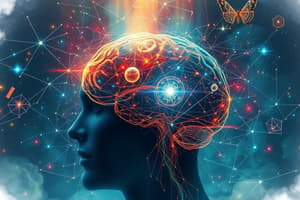Podcast
Questions and Answers
What is sensation?
What is sensation?
- Processing of sensory signals
- Detection of external stimuli and transmission of this information to the brain (correct)
- The experience of hearing
- None of the above
What is perception?
What is perception?
Processing, organization, and interpretation of sensory signals.
What is bottom-up processing?
What is bottom-up processing?
Perception based on the physical features of stimuli.
What is top-down processing?
What is top-down processing?
What is sensory coding?
What is sensory coding?
What is transduction?
What is transduction?
What does psychophysics study?
What does psychophysics study?
What is the absolute threshold?
What is the absolute threshold?
What is the difference threshold?
What is the difference threshold?
What does Weber's Law state?
What does Weber's Law state?
What is signal detection theory?
What is signal detection theory?
What is sensory adaptation?
What is sensory adaptation?
Do ESP (extrasensory perception) abilities exist?
Do ESP (extrasensory perception) abilities exist?
What is the pathway of light through the eye?
What is the pathway of light through the eye?
What is the retina?
What is the retina?
What are the two types of receptor cells in the retina?
What are the two types of receptor cells in the retina?
What is the fovea?
What is the fovea?
What is the dorsal stream specialized for?
What is the dorsal stream specialized for?
What does trichromatic theory explain?
What does trichromatic theory explain?
What is the opponent-process theory?
What is the opponent-process theory?
What are the rules of Gestalt perceptual grouping?
What are the rules of Gestalt perceptual grouping?
What is binocular disparity?
What is binocular disparity?
What is the hearing pathway?
What is the hearing pathway?
What are the five basic taste sensations?
What are the five basic taste sensations?
What are pheromones?
What are pheromones?
What is the definition of audition?
What is the definition of audition?
Flashcards are hidden until you start studying
Study Notes
Sensation and Perception Overview
- Sensation: The process of detecting external stimuli and transmitting this information to the brain.
- Perception: Involves the processing, organization, and interpretation of sensory signals.
Processing Types
- Bottom-up Processing: Perception relies on the physical features of stimuli.
- Top-down Processing: Perception influenced by prior knowledge and expectations.
Sensory Mechanisms
- Sensory Coding: How sensory receptors convert physical properties of stimuli into neural impulse patterns.
- Transduction: Conversion of sensory stimuli to signals interpretable by the brain.
Psychophysics
- Psychophysics: Examines the relationship between physical stimuli and psychological experiences.
Thresholds
- Absolute Threshold: The minimum intensity needed to detect a sensation.
- Difference Threshold: The smallest change needed to notice a difference between two stimuli.
- Weber's Law: The just noticeable difference is proportional to the original stimulus rather than a fixed amount.
Signal Detection Theory
- Signal Detection Theory: Analyzes decision-making based on stimulus presence, including sensitivity and bias in perceptions.
Sensory Adaptation
- Sensory Adaptation: Diminished sensitivity to constant stimulation over time.
Eye Structure and Function
- Light Pathway: Light travels through the cornea, pupil, iris, lens, and reaches the retina.
- Retina: Contains sensory receptors (rods for low light; cones for color perception) that transduce light into neural signals.
Visual Processing
- Ventral Stream: Responsible for object recognition ("what").
- Dorsal Stream: Handles spatial perception ("where").
Color Vision Theories
- Trichromatic Theory: Suggests three types of cones sensitive to different wavelengths (blue-violet, yellow-green, red-orange).
- Opponent-Process Theory: Proposes ganglion cells work in opposing pairs (red-green and blue-yellow) to create color perception.
Gestalt Principles of Perception
- Proximity: Grouping figures based on closeness.
- Similarity: Grouping figures that resemble each other.
- Continuity: Preferring continuous forms; good continuation.
- Closure: Completing figures with gaps.
- Illusory Contours: Perceiving depth cues without existing contours.
Depth Perception Cues
- Binocular Depth Cues: Require both eyes (e.g., binocular disparity).
- Monocular Depth Cues: Available to each eye alone (e.g., occlusion, relative size).
- Pictorial Depth Cues: Influence perceived depth from one eye's perspective.
Object Constancies
- Size Constancy: Understanding an object's size based on distance.
- Shape Constancy: Recognizing shapes from different angles.
- Color Constancy: Correctly perceiving colors under varying lighting.
- Lightness Constancy: Judging lightness based on light reflection relative to surroundings.
Auditory Perception
- Audition: The process of hearing sound.
- Sound Wave Characteristics: Amplitude determines loudness; frequency (20-20,000 Hz) determines pitch.
- Hearing Pathway: Sound travels from outer ear to auditory cortex through a series of structures.
Taste and Smell
- Gustation: Sense of taste with five basic sensations (sweet, sour, salty, bitter, umami).
- Olfaction: Sense of smell; involves chemical receptors in the nasal cavity and the olfactory bulb.
Touch and Pain
- Haptic Sense: Encompasses temperature, pressure, and pain sensation.
- Kinesthetic Sense: Awareness of body positions and movements.
- Pain Types: Fast fibers for sharp pain; slow fibers for dull pain.
Pain Management
- Gate Control Theory: Interaction of biological, psychological, and cultural factors in pain perception.
- Pain Control Methods: Drug treatments, cognitive strategies, and understanding the impact of attention on pain.
Studying That Suits You
Use AI to generate personalized quizzes and flashcards to suit your learning preferences.



